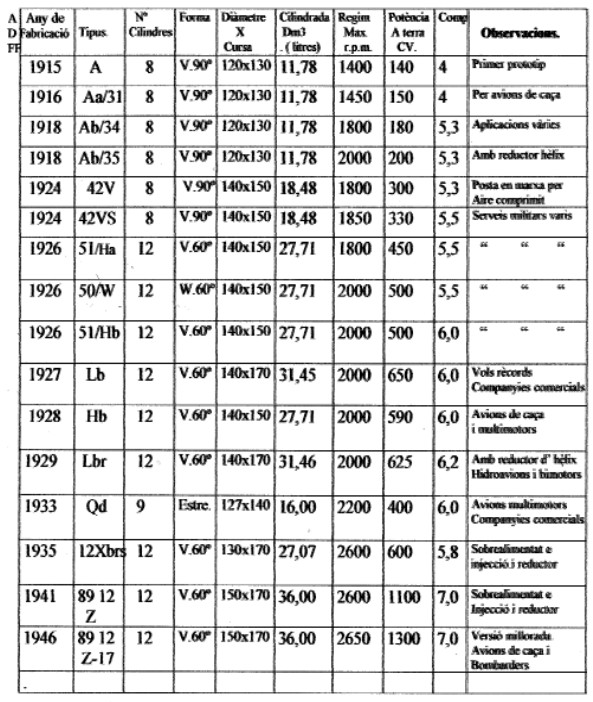Updated: 15-May-2019
HISPANO - SUIZA (Cronologic)
(Spain / France)
In this chapter we give a chronological summary for this brand's piston-engine production.
-As mentioned in the main Hispano Suiza chapter, the first aviation engine was Type 31.
-In its two versions, with 11 and 8 air-cooling fins in the lower part of the cylinders.
-Both versions gave 140 CV at 1,400 rpm but with a small difference; the first had 120 bore and 120 mm stroke and the second had the same bore by 130 mm of stroke.
-The next similar engine was a derivative from the automotive Type 32. This was Type 33 that was geared, and gave 200 CV at 2,000 rpm. Its cylinder dimensions were 100 bore by 150 mm stroke.
-That was what appeared until the year 1915.
-In France the typical French denomination is applied, consisting of a number for the number of cylinders, a capital letter for the model and several lowercase letters for the technical add-ons.
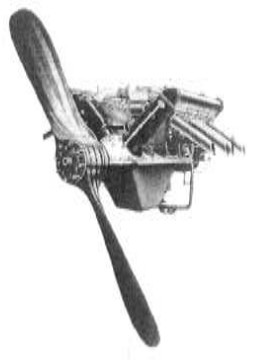
“Tipo 34”
-The year 1916 was the official approval for Type 34, already known as 8Ac that was totally water-cooled. It gave 150 CV, and Type 34S or 8Ab gave 180 CV.
-It was also the year for the Types 35 and 36 that gave 200 CV with 120 mm bore and 130 mm stroke. Both engines were geared. And this same year the Type 37 prototype with 150 CV came out. It was a lightened version of Type 35 (8B).
-The year 1917 was very productive due to WWI.
-Type 34 went into production until 1919 as well as Type 34S in enforced 8Ab versions.
-Type 34S 8Ac version was a study engine with greater compression and the 34S 8Ad version giving 208 CV at 1,850 rpm had a flexible transmission for the magnetos.
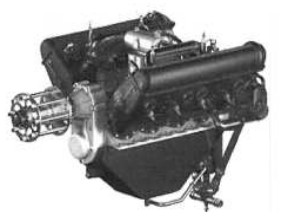
“Tipo 35”
-The Type 35 engines were varied for the first, the 8Bac was somewhat more reinforced and gave 208 CV. The 8BbD was the 39 8Db variant. The 8BbE (was the Type 40 8Eb variant and gave 210 CV).
-The Type 35S (8Bc, 8BcD and 8BcE) gave 223 CV, varying the reduction ratio for the propeller. Some Type 35 (8Bec and 8C) were "Cannon engines".
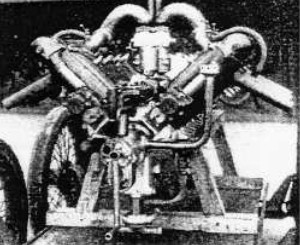
“Tipo 36”
-Type 38 (8Ca, at the Nasm) had a 5-shot cannon in the middle of the V cylinder banks.

“Type 38, at the Nasm”
-Type 39 (16D) was interesting for being a tandem of 2 Hispano Suiza 8V engines totaling 400 CV. See main chapter.
-Type 40 (8E) was intended for airships with a strong reduction because rotating the engine at 2,000 rpm, the propeller did it at 710 rpm.
-Type 42 (8Fb) gave 300 CV with cylinder-dimensions of 140 mm bore by 150 mm stroke, more than previous engines whose average was 120 by 130 mm. It had a direct output to the propeller.

“Type 42”
-Type 43 (8Fa) with cylinders of 140 mm bore and 140 mm stroke gave 300 CV but at 100 rpm more than the 8Fb, which was 1,900 rpm.
-It was a prototype with 30/40 reduction gear and a 5-shot cannon.
-Type 44 was the 8Cb giving 200 CV with gearbox and cannon. In Italy it was made by Itala and the one in the photo is at the Polito in Turin.
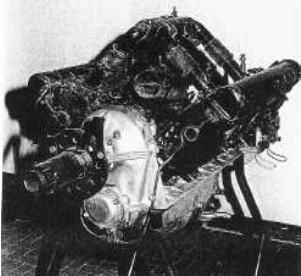
“Type 44 at the Polito”
-In the year 1918 the Type 31M was officially approved (for marine use, hydros). Together with Type 35 version 8Bda and 35S version 8Bed.
-The different derivatives from Type 44, like the 8Ca, 8Cd and 8Ce giving 200/220 CV depending on whether they were 2,000 or 2,100 rpm. They were all cannon-engines.
-The last approval that year was for Type 45 (8Fc) giving 350 CV with the crankshaft rotating at 2,000 rpm, and the propeller at 1,500 rpm.
-In 1919 Type 41 and 42 came out in S and M versions (for hydros).
-Until 1923 Type 41 and 41S (8Ac) were developed and they started with the 12-cylinder engines in V and W like Type 50 or 12 G, using three banks of 4-cylinder blocks for the W. With 450 CV. (see text in the main chapter).
-Type 51 or 12H used the cylinders of the Type 42 engine, giving 450 CV at 1,800 rpm.
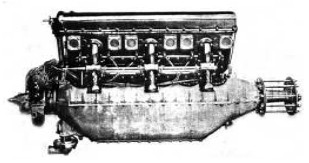
“Type 51”
-Type 52 (12J) with cylinders from Type 34 gave 350 CV at 1,800 rpm.
-In 1923, normal production recovered once relations with the French government had been restored.
-Types 41 and 41S were still made as well as Types 50 (W12G), 51 (V12H) and 52 or V12J.
-From 1924 the different Ga, Ha and Ja variants of the previous twelve-cylinder engines are made. In 1925 they made the Gb, Hb and Jb versions of the same engines.
-From the previous 8Vs only Type 42 is developed with improvements in 1926, and its production would continue until 1933.
-In 1927 the W12Kb 600/620 CV (Type 50) appears together with Type 51 model V12La, 550 CV.
-1928 is the year of the V12 Hbr, Lb, Lbr (Type 51). And Type 57 or V12 Mb and Mbr. The V12 Nb and Ns engines were the Type 61, coming out that same year.
-Different kind of engines were the Type 62 and 63 with 6 cylinders in line that used the individual blocks from the type 46bis and 56bis engines, respectively.
-In 1929 Type 41, 51, 57, 61 and 63 continued to be developed with different additions such as varying the compression ratio, etc.
-The Types 57, 61 and 67 were evolving in 1930, and they began with the Wright license for the "Whirlwind" R-975 to build the R9Qa, Hispano Suizo's first radial engine.
-In 1931 they continued with the 61 and 65 as well as the newly initiated R9Q (b, c, ..) radial engine.
-In 1932 the excellent Types 72 and 73 came out. The former a V12 X and the latter a V12 Y that were built under license by many countries and they were used in WWII. The R5Q and the (Clerget) R9T and R14U Diesel engines were started to be manufactured too. The R9V was a Wright license for the Cyclone R-1820.

“H-S V12Y engine at Safran”
-In 1934 they continued evolving with the previous mentioned engines, besides they made Type 72 Xbr and Xbrs as well as Type 73 Ydr and Ydrs that gave way to the 76 Xcrs and Xers and these to the 77 Ycrs and Ygrs.
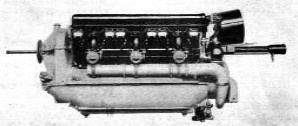
“12 Ybrs Cannon engine”
-The cannon of the above photo was a 20 mm Oerlikon modified by Birkigt. We see that it sticks out from the front and from the rear, with special attention to the ammunition drum.
-In 1935 Type 79 or R14Aa is added. This is a radial engine that gave 1000 CV and more.
-Then Types 73 and 77 follow, using Szydlowski-Planiol compressors.
-From 1937 are the V12 Type 72 and 76 engines that incorporate fuel injection, the Xirs/B and Xirs/A.
-Type 80 came out in 1938 being the R14Ab radial engine.
-The 82 and 90 came out the same year. They were the H24Y that gave 2,000 CV at 2,400 rpm, as prototypes though.
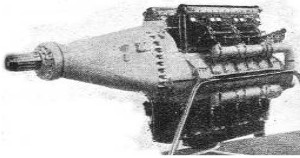
“H24 prototype: 2 compressors and 12 carburetors”
-In 1939 they started to use Szydlowski-Planiol, Brown-Boveri and Rateau Turbo-compressors in Type 77 and they started with the Type 89 (V12 Z) that gave 1,200/1,300 CV.

“Hispano Suiza V12 Z-89”
-The design and evolution of the -89 began in Bois-Colombes and because of WWII it moved to Tarbes, in the south of France next to the Pyrenees, and later to Barcelona, to the parent company of Hispano-Suiza.
- There they would go first to the HA.1109-JL, airplanes built by Hispano-Aviación in Seville. These airplanes were built under license from the Me-109. Later these aircraft would be powered by RR Merlin engines.
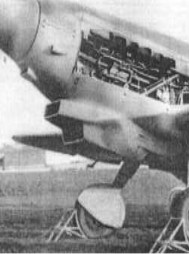
“Hispano Aviación HA-1109 JL, with 12Z-89”
-After the conflicts were finished in 1946, Type 95 or H24Z came out with four cylinder blocks from the 12Z placed in H configuration. And in 1947 Type -89 and Type -91 followed. They were derived from the previous one.

“The 24Z can be seen at the MAE”
-1948 was exclusively destined to other V12Z variants, the -M or 12Z-ter transformed into 12Z-17 and they were made in Bois-Colombes and Barcelona.
-The V12Z-20 with a 2-speed Szydlowski-Planiol compressor and the V-12Z-I with a Hispano-Suiza compressor. There was a prototype with turbocharger, V12Z-T.
-Finally, the piston engine-era in Hispano Suiza ends with Types 100 and 100A in the year 1949, and these engines were the V-12B (the alphabet was re-started).
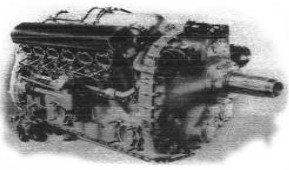
“El V12B, Type 100”
Note: The information of this chronological production review on Hispano-Suiza as well as that referring to the summarized historical development, has been obtained from M. Lage, specialized in Hispano Suiza, via J. Garcia from "Amigos del Museo de Cuatro Vientos" (Friends of the Cuatro Vientos Museum).
From Appendix 6: The main text is mostly about the development that Hispano-Suiza had in France. But the production in Barcelona was not negligible.
-Production of Hispano Suiza aviation engines in Barcelona, between 1915 and 1952.
